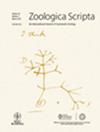Species delimitation and phylogenetic relationships of the Prionospio complex (Annelida, Spionidae) in the Northeast Atlantic
IF 2
2区 生物学
Q2 EVOLUTIONARY BIOLOGY
引用次数: 0
Abstract
The Prionospio complex comprises the most diverse and complex group within the polychaete family Spionidae. The phylogenetic relationships within the group are still poorly understood, and the generic breakdown is unstable. In this study, we assessed the diversity, relationships, and distribution of species of the Prionospio complex occurring in Norwegian waters. We analysed mitochondrial genomes and nuclear ribosomal DNA assembled via whole-genome shotgun sequencing, and Sanger sequenced fragments of COI and 16S rDNA. Sanger sequencing proved challenging in the group, where COI was only amplified successfully in 14% of specimens. By molecular species delimitation algorithms, our study revealed the presence of four well-supported but currently undescribed species of Prionospio in Norwegian waters. We observed a novel distribution pattern of polychaetes in coastal waters, where certain species demonstrated distribution ranges spanning over 7000 km. Such wide distribution parallels patterns of deep-sea Prionospio species, suggesting that factors beyond recent anthropogenic translocations are involved. Our analysis of 38 mitochondrial genomes and ribosomal nuclear DNA enabled us to hypothesise on the phylogenetic relationships of 14 species of the Prionospio complex. The analysis suggested that two characters previously used to designate genera: the beginning of the branchiae from chaetiger 3 and the presence of pinnules on the branchiae, might have evolved more than one time within the complex. We return Aurospio banyulensis to the genus Prionospio according to the diagnosis of Aurospio resulting tree where this species was nested among Prionospio species. Our findings provide new insights into the diversity and distribution patterns of Prionospio species and contribute to a better understanding of marine benthic biodiversity and the importance of taxonomic accuracy in conservation and management practices.东北大西洋 Prionospio 复合物(无脊椎动物,匙吻鲟科)的物种划分和系统发育关系
Prionospio 复合体是多毛目蛛形纲中最多样、最复杂的类群。目前对该类群的系统发育关系还不甚了解,其属种划分也不稳定。在这项研究中,我们评估了挪威水域中出现的Prionospio复合体物种的多样性、关系和分布。我们分析了通过全基因组枪式测序组装的线粒体基因组和核核糖体 DNA,并对 COI 和 16S rDNA 片段进行了 Sanger 测序。事实证明,Sanger 测序在该群体中具有挑战性,只有 14% 的标本成功扩增出 COI。通过分子物种划分算法,我们的研究揭示了挪威海域存在四个证据确凿但目前尚未被描述的 Prionospio 物种。我们观察到多毛目环节动物在沿海水域的新分布模式,其中某些物种的分布范围超过 7000 千米。这种广泛的分布模式与深海 Prionospio 物种的分布模式相似,表明除了近期的人为迁移之外,还涉及其他因素。通过对 38 个线粒体基因组和核糖体 DNA 的分析,我们对 Prionospio 复合体 14 个物种的系统发育关系做出了假设。分析结果表明,以前用于指定属的两个特征:从螯3开始的分枝和分枝上的羽片,可能在该复合体中进化了不止一次。根据 Aurospio 的诊断结果树,我们将 Aurospio banyulensis 归入 Prionospio 属。我们的发现为了解 Prionospio 种类的多样性和分布模式提供了新的视角,有助于更好地理解海洋底栖生物多样性以及分类准确性在保护和管理实践中的重要性。
本文章由计算机程序翻译,如有差异,请以英文原文为准。
求助全文
约1分钟内获得全文
求助全文
来源期刊

Zoologica Scripta
生物-动物学
CiteScore
5.60
自引率
0.00%
发文量
52
审稿时长
>12 weeks
期刊介绍:
Zoologica Scripta publishes papers in animal systematics and phylogeny, i.e. studies of evolutionary relationships among taxa, and the origin and evolution of biological diversity. Papers can also deal with ecological interactions and geographic distributions (phylogeography) if the results are placed in a wider phylogenetic/systematic/evolutionary context. Zoologica Scripta encourages papers on the development of methods for all aspects of phylogenetic inference and biological nomenclature/classification.
Articles published in Zoologica Scripta must be original and present either theoretical or empirical studies of interest to a broad audience in systematics and phylogeny. Purely taxonomic papers, like species descriptions without being placed in a wider systematic/phylogenetic context, will not be considered.
 求助内容:
求助内容: 应助结果提醒方式:
应助结果提醒方式:


